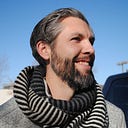“I am one with the Force, and the Force is with me.”
Author’s note: this one was originally published a few years ago over at my now defunct blog The Academy. I don’t normally recycle content, but seeing as how today is Star Wars day (May the 4th…get it?), it seemed like a good time to open up the vault. Enjoy!
To ring in the new year, my wife and I went to go see Rogue One the other morning, and I have to say I was pretty pleased with it. Going in I had some idea of what to expect in terms of the story, so mostly I was curious how they were going to connect A to B. From the trailers I knew that it was going to be a whole new cast of characters, and I was a little skeptical that they’d be able to create a team that I would feel compelled to root for, knowing that [SPOILER ALERT] they’re all going to die. And to be honest, I think that skepticism was justified, since I didn’t really connect with Jyn Erso (Felicity Jones) or Cassian Andor (Diego Luna), or any of the other members of the motley crew they throw together over the course of the film (except for Sheldon-bot — he was pretty sweet). Nor was the villain particularly menacing; cold-hearted, ruthless, and self-interested, sure, but not menacing (that was saved for the 5 minutes of screen time devoted to Darth Vader. Once again we’re reminded what was so compelling about him in the first place).
There was, however, one character that stood out to me, but it took a while to figure out why. That character is Chirrut Îmwe, played by Donnie Yen. You’ll be forgiven for not knowing his name; I don’t think it was spoken aloud once during the film. He’s this guy:
You know, the blind Chinese monk archetype who’s not a Jedi, but is pretty much a Jedi, and who makes you wonder why Storm Troopers even bother wearing armor if it can’t deflect a stick. But his understated badassery is not why I think he’s interesting. You see, he’s the first religious character in the Star Wars cinematic universe.
In Episode IV, Han has this famous line:
“Hokey religions and ancient weapons are no match for a good blaster at your side, kid.”
Notice that Han refers to the lightsaber as an “ancient” weapon, and completely dismisses the Force. And then of course there’s this iconic scene:
Again, there’s the reference to an “ancient” religion. But according to the timeline, this can’t be more than 20 years after Episode III, and in the prequels there seem to be Jedi running around all over the place! The practice may be ancient, but it certainly shouldn’t be forgotten and derided after only twenty years. And the Jedi are clearly well-known all over the galaxy. Tatooine is supposed to be way out on the outer reaches, far from the center of civilization, and yet Watto, a junkyard owner, knows enough about them to recognize the Jedi mind trick. I guess he’s got space wi-fi in his shop.
But Jedi-ism doesn’t really qualify as a religion in the first place. One of the defining characteristics of a religion is the reliance on faith, a belief for which there is no proof. The Force is definitely real. This is demonstrated time and time again, as the Jedi use it to jump impossibly high, smash droids, feed hungry young senators, and (most disturbingly of all) distort the minds of the weak. No faith required! So Jedi-ism is neither ancient nor a religion.
Which is what makes our Chinese monk so interesting. We never see him actually use the Force, and he claims not to be a Jedi, but he definitely believes in it. In fact, as far as I’m aware, he’s the first character we see pray in any of the Star Wars movies. There are a couple things he does which certainly suggest he’s “attuned” to the Force, like knowing when someone has murderous thoughts or his amazing fighting abilities despite being unable to see, so it’s not totally blind faith. But it’s certainly the closest thing we’ve seen so far in the Star Wars universe, and it’s really the only attempt to legitimize the Jedi “faith” as an actual religion.
What would have made this kind of fun in the prequels is if we saw Obi-wan and Anakin traveling to planets that have temples to the Jedi order, but none of the “Jedi” there can use the Force. How interesting would it be to see them walking around and being totally brushed off by the local populace instead of being instantly respected and feared? Anakin bumps into a guy on the street, only to be told “Sorry, I haven’t got any credits for you today.” Or how about this: Anakin starts off as a really good guy who wants to join the Jedi order on his home world, only to become disillusioned by the fake Jedi, but who is then noticed by the Sith and seduced to the Dark Side in order to actually gain his powers. It would be his obsession with being a real Jedi, and his belief that he can convert Darth Maul, that are ultimately his undoing, rather than some ham-handed love story. I guess it’s way too late to wish for some real character development from the prequels, but a man can dream, can’t he?
